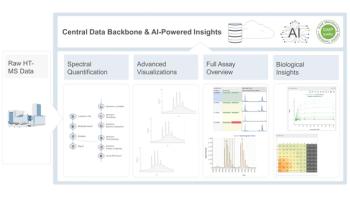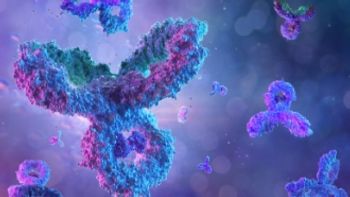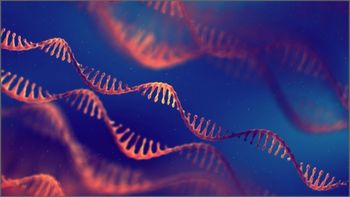
- The Column-07-22-2016
- Volume 12
- Issue 13
Urine Analysis: The Good, the Bad, and the Ugly
In clinical and forensic/toxicology laboratories, urine is a preferred matrix from which to quantify drug concentrations because it yields accurate results and allows for noninvasive collection methods. Prior to excretion, drug metabolites in the body undergo a glucuronidation reaction, resulting in a glucuronide bond that must be cleaved before mass spectrometry (MS) analysis by a β-glucuronidase enzyme hydrolysis. Many laboratories employ a “dilute-and-shoot” method after hydrolysis to decrease residual protein or enzyme concentration, but this method negatively affects column lifetime and reduces the sensitivity of analyte detection. By using a β-glucuronidase removal approach, analysts are able to see an increase in sensitivity and a reduction in MS instrument maintenance.
In clinical and forensic/toxicology laboratories, urine is a preferred matrix from which to quantify drug concentrations because it yields accurate results and allows for noninvasive collection methods. Prior to excretion, drug metabolites in the body undergo a glucuronidation reaction, resulting in a glucuronide bond that must be cleaved before mass spectrometry (MS) analysis by a β-glucuronidase enzyme hydrolysis. Many laboratories employ a “dilute-and-shoot” method after hydrolysis to decrease residual protein or enzyme concentration, but this method negatively affects column lifetime and reduces the sensitivity of analyte detection. By using a β-glucuronidase removal approach, analysts are able to see an increase in sensitivity and a reduction in MS instrument maintenance.
Advances in drug testing are in direct correlation to the epidemic of drug abuse that has plagued society for decades. Most of the public is familiar with drug testing, whether it is because of a mandated test before a new job, post-accident testing at work, or from watching crime TV shows. For laboratory analysts, determining the best testing and sample preparation methods is essential. Urine is the favoured sample matrix for drug testing because it is simple to collect and yields accurate results, yet it still requires a pretreatment step and sample preparation before liquid chromatography–mass spectrometry (LC–MS) analysis. Because clinical and forensic toxicology laboratories may be performing thousands of tests a month, a reliable analysis method is crucial.
An understanding of how drugs are metabolized in the body is critical to assessing how to work with urine as a sample matrix. The drug metabolism pathway leads the compounds to the liver where they undergo a glucuronidation reaction resulting in a glucuronide molecule. The change in chemistry causes the compound to become more polar and aids in the absorption into the kidneys, facilitating the excretion of the compounds in urine.1,2 Scientists often prefer analyzing urine over serum or blood to quantify drug concentrations because non-invasive collection methods result in more accurate conclusions.
Although urine is an easy sample matrix to work with, a small amount of sample preparation must occur before analysis can begin. To ensure accurate separation by LC–MS, the extremely polar glucuronide bond resulting from drug metabolism needs to be cleaved. Scientists use an enzyme or acid hydrolysis to cleave the bond from the drug analyte. Acid hydrolysis can introduce harmful solvents into the sample and can change the chromatography by altering analytes’ separation time. A more effective hydrolysis method uses β-glucuronidase to perform an enzymatic hydrolysis, but the resulting solution now contains analytes of interest and residual enzyme.3 If the enzymes are injected onto a high performance LC (HPLC) or ultrahigh-pressure LC (UHPLC) column, they can be detrimental to column lifetime and increase system maintenance requirements.
Injecting proteins or enzymes onto a column is a sure way to increase backpressure, because as the proteins build up, they clog and ultimately kill the column. Instead, scientists frequently employ a “dilute-and-shoot” method to attempt to reduce the concentration of β-glucuronidase, which involves a dilution of the sample followed by injection onto the column. A typical dilution can range from 10:1 up to 30:1. While this addresses certain issues, it also reduces the concentration of the analytes in the sample. This in turn negatively affects the overall analysis and reduces the sensitivity, making it difficult to accurately quantify drugs of interest. Specific analytes, such as norbuprenorphine and buprenorphine, are commonly susceptible to ion suppression when diluted in the sample matrix,4 further complicating the analysis. The “dilute-and-shoot” method may be simple, but other techniques provide better chromatography results while reducing harmful damage on the column and instruments.
Scientists use protein precipitation as another method to reduce β-glucuronidase in the sample. Advances in protein precipitation products have made it easier to decrease the protein or enzyme content in hydrolyzed urine samples. The traditional method of spinning down proteins and removing the supernantant is improved by using a protein precipitation plate to act as a filter that removes the proteins. This protein removal technique is becoming a standard sample preparation method for laboratories that need a cleaner sample matrix and an increase in analyte concentration. While protein precipitation appears to be a superior alternative to “dilute-and-shoot”, components need to be assessed. Despite the advantages of protein precipitation, the protocol typically involves a 3:1 or 4:1 dilution for the protein or enzyme to effectively precipitate out of solution. This dilution factor is much lower than “dilute-and shoot”, but it may still have an effect on the sensitivity of analytes when running the tests. The technique can take about 15 min to run and even though plates process 96 samples at once, laboratories running 1000 samples per day cannot afford to add 15 min per plate to precipitate the protein or enzyme out. While protein precipitation offers a competitive and efficient way to remove β-glucuronidase from samples, there may be a better option that fits the requirements of many laboratories.
A new method involves a targeted sample preparation product that is easy to use, works in about one minute, and eliminates the large dilution factors and other problems that traditional methods experience. In one step, β-glucuronidase is removed from the sample in the same amount of time as a traditional “dilute-and-shoot”.
Method
Experimental Conditions: Column: 50 x 2.1 mm, 2.6-m biphenyl Kinetex (Phenomenex); mobile phase: A: 0.1% formic acid in water, B: 0.1% formic acid in acetonitrile; gradient: 0.0 min at 5 %B, 3.0 min at 95 %B, 4.0 min at 95 %B, 4.1 min at 5 %B; flow rate: 500 L/min; temperature: ambient; detection: MS–MS (Sciex API 4000).
β-Gone Procedure: To 200 L spiked urine (spiked at 100 ng/mL), add 133 L 0.1% formic acid in methanol. Pass through -Gone tube (Phenomenex) or 96-well plate and collect eluent.
Dilute-and-Shoot Procedure: Dilute spiked urine (spiked at 100 ng/mL) 10-fold with 0.1% formic acid in water.
Results
To compare the sensitivity gains, THC-COOH in urine was analyzed by dilute-and-shoot and the β-glucuronidase removal method, resulting in more than 3x greater sensitivity using the β-glucuronidase removal method (Figure 1). Compared to protein precipitation methods, the β-glucuronidase removal method greatly reduced the amount of time required without negatively affecting analyte recovery. This is because a specialized chemistry that targets and removes β-glucuronidase but does not negatively affect the analytes’ recovery. Recoveries range from 70–114% using the β-glucuronidase removal product on both recombinant and non-recombinant forms of the β-glucuronidase enzyme.
Because there are many sample preparation techniques available for urine drug testing, the requirements of specific laboratories need to be considered. Laboratories that are concerned about their instruments and columns and want to reduce costs in the long run, yet still save time, can benefit from using a specialized β-glucuronidase removal product. If time is not a concern, but the laboratory still requires an uncontaminated sample, protein precipitation is a viable option. If labs are pressed on time and need an inexpensive short term solution, “dilute-and shoot” may be the best route to go temporarily, but another sample preparation technique should be considered to protect the longevity of instruments and to eliminate the possibility of undetected analytes. Drug testing makes up a large part of the workload for clinical and forensic toxicology laboratories and any developments that simplify the process can help the industries become more efficient and effective.
References
- H.A. Heit and D.L. Gourlay, The Journal of Pain and Symptom Management 27(3), 260–267 (2004).
- Joseph K. Ritter, Chemical Biological Interaction 129(1–2), 171–193 (2000).
- Birgit L. Coffman, Christopher D. King, Gladys R. Rios, and Thomas R. Tephly, The American Society for Pharmacology and Experimental Therapeutics 26(1), 73–77 (1998).
- Karen J. Regina and Evan D. Kharasch, Journal of Chromatography B Analytical Technologies in the Biomedical and Life Sciences 939, 23–31 (2013).
- Substance Abuse and Mental Health Services Administration, Results from the 2012 National Survey on Drug Use and Health: Summary of National Findings, NSDUH Series H-46, HHS Publication No. (SMA) 13-4795. Rockville, MD: Substance Abuse and Mental Health Services Administration, 2013.
Jenny Cybulski graduated from Vanguard University with a B.S. in biology and a minor in chemistry and now works as a Product Communications Manager at Phenomenex.
Articles in this issue
over 9 years ago
Waters Collaborates with BTI on Glycosphingolipid Projectover 9 years ago
Researchers Use Chip CE to Investigate Rhinovirus Replicationover 9 years ago
The International Symposium on GPC/SEC and Related Techniquesover 9 years ago
The Evolution of MIPsover 9 years ago
Vol 12 No 13 The Column July 22, 2016 Europe and Asia PDFover 9 years ago
Vol 12 No 13 The Column July 22, 2016 North American PDFover 9 years ago
Onshoring Your Insourced Solutions?Newsletter
Join the global community of analytical scientists who trust LCGC for insights on the latest techniques, trends, and expert solutions in chromatography.





